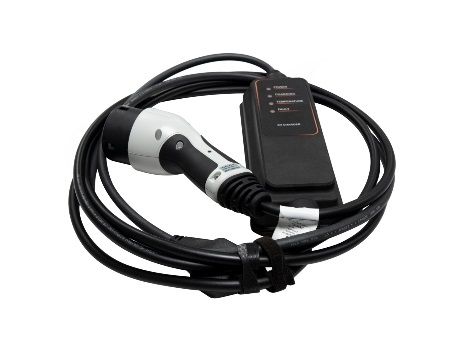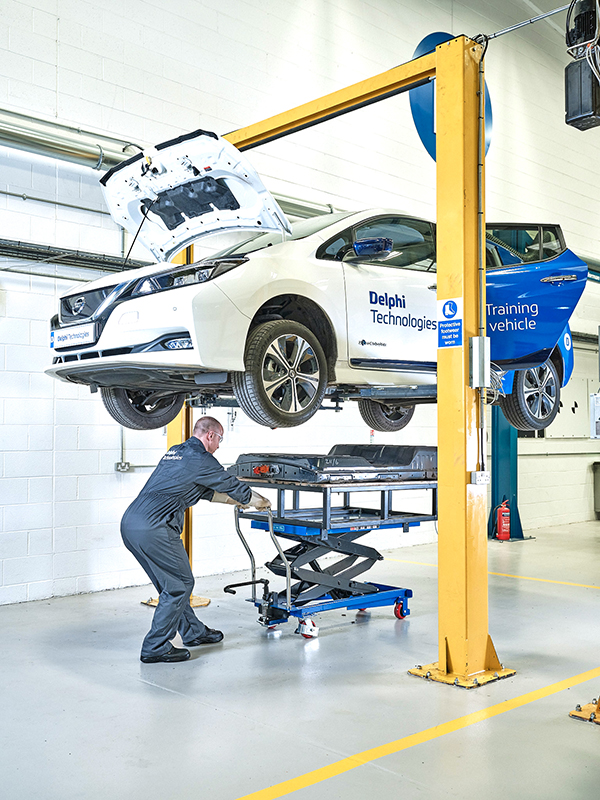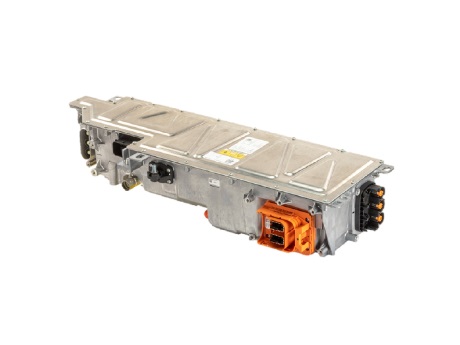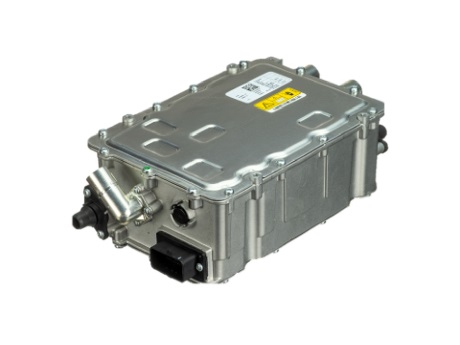Charge Mode 2 Cables

Proven durable EV charging cables that last
Delphi Charge Mode 2 Cables are in serial production at multiple major OEMs. Tested according to automotive Standards (LV124), our proven design offers reliability and performance that exceed well beyond compliance. The In-Cable Control- and Protection Device (IC-CPD) allows drivers to safely charge their battery-powered electric vehicle (BEV) or plug-in hybrid electric vehicle (PHEV) without the need for a dedicated circuit or EV charging station.
Our robust design of the in-cable control (ICC) box make it not only drive over resistant* (acc. IEC 62196-1) but able to handle extreme temperatures ranging from -30°C (-22°F) to +50°C (122°F), all the way up to +70°C (158.0°F) in storage. With superior water sealing protection* of immersion in 1 meter, well beyond the 5cm standard* (IP67 High sealing performance (1 meter)), the IC-CPD is durable enough for anything nature throws at it.
And to ensure a service life that lasts just as long as the expected battery life of a vehicle, our IC-CPD is designed to last over 10,000 mating cycles- That adds up to a service life of 9 years if used 3 times a day!
Safe EV charging to protect you and your vehicle
When working on anything electrical, safety is our top priority. That’s why Delphi Charge Mode 2 Cables are fully compliant with the IEC 62752 standard and protect you and your vehicle from dangerous electrical faults that can cause damage, shock, fire, or worse.
Shock protection: When the vehicle charging inlet and grid socket are properly connected, all terminal interfaces and terminals are fully protected against contact. Type B RCD residual current detection (RCD) detects fault currents and disable the charging process.
(NA ONLY) Ground monitoring: IC-CPD measures the protective conductor resistance and stops the charging process if the measured value is too high.
Overheating protection: Dual thermal sensors in the grid plug and sensors inside the ICC box monitor temperature.
Short circuit protection: Short-circuit management capability, will the IC-CPD protects on short circuits at EV.
Overvoltage protection: IC-CPD protects EV from overvoltage.
| Countries* | Connector Type | Current | Charge Level | Cable Length (m/ft) | Grid plug type | Part Number |
| North America | SAE J1772 / Type 1 | 10A | Level 1 | 5.0 / 16.42 | NEMA 5-15 / 90° | PLV10001-11B1 |
| Europe | Type 2 | 10A | Level 1 | 5.0 / 16.40 | Typ E/F 90° | PLV10003-12B1 |
| UK | Type 2 | 10A | Level 1 | 5.0 / 16.42 | Typ G | PLV10005-12B1 |
| Switzerland | Type 2 | 8A | Level 1 | 5.0 / 16.44 | Typ J 90° | PLV10007-12B1 |
| Norway | Type 2 | 10A | Level 1 | 5.0 / 16.45 | Typ E/F 180° | PLV10008-12B1 |
| Denmark | Type 2 | 6A | Level 1 | 5.0 / 16.43 | Typ K 90° | PLV10010-12B1 |
| Finland | Type 2 | 8A | Level 1 | 5.0 / 16.41 | Typ E/F 90° | PLV10011-12B1 |
| Italy | Type 2 | 8A | Level 1 | 5.0 / 16.46 | CEI 23-50 / 90° | PLV10009-12B1 |
| China | GB/T | 8A | Level 1 | 5.0 / 16.42 | GB 2099 / 90° | PLV10015-12B1 |
*For a full list of countries available, please contact your Delphi representative.
| What is Level 1 AC charging? | A charging “level” in EV terminology refers to the electric power distribution type, standards, and maximum power of a charging system as defined by SAE J1772 and internationally adopted under IEC 62196-1. Sometimes referred to as “trickle charging”, level 1 charging is perfect for plug-in hybrid vehicles and offers a great alternative charging option by providing a home charging station. By using existing infrastructure, electric vehicle owners save on installation costs while still being able to fully charge their battery overnight. And because the charger is portable, it can easily be stored in any EV luggage compartment, making it perfect for short commutes, overnight charging, or an emergency charge. | A “Level 1” AC charge pulls electrical energy from the power grid via a standard 120V household outlet and capable of supplying an average maximum of 16 A and 1.92kW. The electric vehicle’s on-board charger then converts and stores this energy for the electric motor. Depending on the vehicle, level 1 charging usually takes 12 to 24 hours to get a full charge on a fully depleted battery. |
| What is mode 2 EV charging? | A charging “mode” in EV terminology refers to the mode of power delivery, control, and protective equipment of a charging system as defined by IEC 61851-1, the international standard for electric vehicle conductive charging systems. | “Mode 2" uses a cable incorporated with a protection device to connect the electric vehicle to a household socket outlets. |
Our cables use In-Cable Control- and Protection Device (IC-CPD) to provide a standard grounded power connection to residential building sockets from 100 V to 240 V 50/60 Hz (depending on the model variant) and a charging current of 6 A up to 16 A.
An alternative EV charging option for peace of mind
For drivers that suffer range anxiety- the fear that a vehicle has insufficient range to reach its destination- having a Charge Mode 2 cable available on hand can offer some peace of mind. It also ensures that your vehicle will be charged and ready for use when needed with automatic reset.
Our built-in Auto-Reset feature provides a restart in the event of a temporary power grid fault, such as excessive voltage or a brownout. The charging dock will automatically clear any error codes when the cause of the temporary error condition returns to normal and then attempt to restart the charge.
To learn more about OE quality aftermarket EV parts you can trust, contact your Delphi representative today.
The Delphi Difference
-
100 years of OE experience, supplier to the world’s top automakers
-
OE heritage and knowledge built into every aftermarket part
-
Comprehensive portfolio for a wide range of vehicles and model years
-
Streamlined SKUs for easy inventory management
-
Support through tools, tips and training

Related product resources and downloads

Electric vehicles in the aftermarket: Are you ready for the repair?
Resource Highlights
The global market for electric vehicles is growing rapidly. And just like their internal combustion engine-powered equivalents, will require timely, efficient servicing and repair as they age. This represents an enormous opportunity for the aftermarket, but critically only for garages who have invested in the equipment and know-how to work safely on these vehicles.
Are you ready?
Global electric vehicle sales grew by 65 percent from 2017 to 2018, settling down to 9 percent growth in 20191. While car sales may have collapsed in the first quarter of 2020, the responses to the pandemic from Europe and China have strongly supported a green recovery with growth in the electric vehicle sector.
The automobile industry is ahead of schedule on approaching the tipping point of when it will be as cheap (and realistic) to own an electric vehicle than one with an internal combustion engine.2 As projected prices of battery packs drop, Wood Mackenzie expects the industry will now reach US$100/KWh a year earlier by 2024.3
Factoring in government incentives, Europe’s EV market increased by 25 percent while China hopes to rebound sales by extending purchase tax exemptions. And although EV sales decreased in the US, California’s recent ban on sales of new gasoline and diesel-powered passenger cars by 2035 might prompt other states to do the same.
Further shifting the electric VIO during the next decade is a wider mix of models available, with vehicle manufacturers planning to introduce an estimated 450 additional models by 2022. If these trends continue, a scenario from IEA predicts the worldwide electrified vehicle fleet will reach 245 million in 2030 - over 30 times above today’s level.4
At the same time, early model hybrid and electric vehicles (H/EV) are transitioning out of vehicle manufacturer’s dealer networks into the aftermarket.
The Toyota Prius, for example, is now over two decades old and requires servicing just as any other vehicle from this era would; they still need their brakes and steering serviced, they have a multitude of electric sensors that fail, and they use
the same OBD-II fault codes. Yet, many garages unfortunately continue to shy away from this work, largely because of the additional hazards that come with high voltage vehicles. By understanding the basic dangers, however, and crucially the processes
required to overcome them, technicians can work safely and competently on H/EVs.
One obvious challenge is the
high-voltage battery. Containing anything from 201.6 Volts to 351.5 Volts (PHEV), they are significantly higher than conventional 12-volt car batteries. The DC battery pack is just one source though; multiple cables
run from the pack to the motor controller, and from the controller to the electric motor, that carries equally dangerous high voltages. Accidental contact with any of these components can be fatal. As well as electrocution, there’s also
the risk of serious burns from arc flash or arc blast, and exposure to harmful battery chemicals. In addition, H/EVs contain magnetic forces that may cause the electric motor or vehicle to move – because of these forces anyone fitted with
a pacemaker should avoid working on the system.

While this may sound alarming, the risks can be mitigated by always following the correct procedures. For example, technicians must wear the right PPE, including CAT 0 1000V-rated insulated gloves and either insulated boots or matting to protect against electrocution. The vehicle should also be secured in a cordoned-off area with appropriate high voltage warning signage. And any keys should be kept away from the vehicle to prevent the accidental operation of electrical systems or movement of the vehicle.
Also, before undertaking even the most routine of jobs, such as replacing the brakes, technicians must first make the car safe. To do so, the high voltage battery should be disconnected by removing the service plug or isolator switch, and again, storing it in a secure location. However, this is not an immediate fix as the high voltage will take some time to dissipate – this can be up to 10 minutes. And even then, the technician should test and prove that the high voltage cables and electrical components are dead prior to carrying out any work on the system.
As a leading OE manufacturer of internal combustion engine, hybrid and electric vehicle technology, we recognize the challenges when it comes to servicing H/EVs.
And because we know these vehicles inside-out, we’re able to provide the skills and know-how to work safely on them. Our specially designed expert-led training courses teach the fundamentals such as the need for specialist PPE, component identification, making the system safe, awareness of magnetic components, use of wiring diagrams and technical data, assessing the high voltage system, and more.
Armed with this knowledge, you’ll be able to take advantage of a fast-growing service opportunity, in an area where there’s still a shortfall of specialist skills. By investing in learning today, garages will be ready for the vehicle technology of tomorrow.
.png?sfvrsn=b4335902_1)


Visit our Technician Library for access to Documents and Downloads
Get in touch
The full Delphi Power Electronics product range

Find out where to buy Delphi parts




